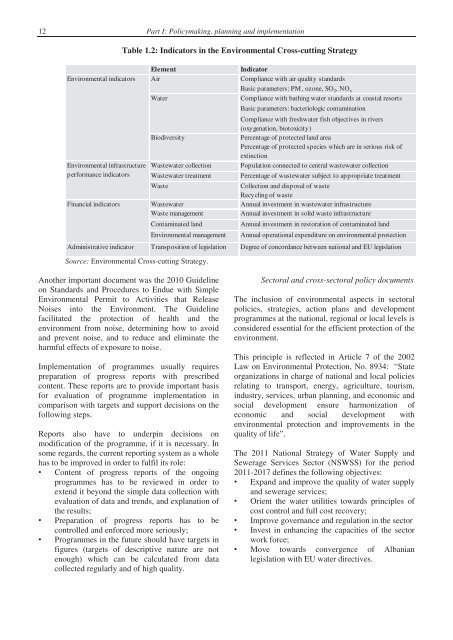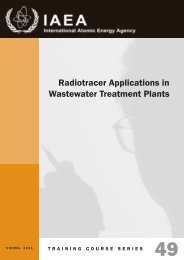Second Environmental Performance Review of Albania
Second Environmental Performance Review of Albania
Second Environmental Performance Review of Albania
Create successful ePaper yourself
Turn your PDF publications into a flip-book with our unique Google optimized e-Paper software.
12 Part I: Policymaking, planning and implementationTable 1.2: Indicators in the <strong>Environmental</strong> Cross-cutting StrategyElementIndicator<strong>Environmental</strong> indicators Air Compliance with air quality standardsBasic parameters: PM , ozone, SO 2 ,NO xWaterCompliance with bathing water standards at coastal resortsBasic parameters: bacteriologic contaminationCompliance with freshwater fish objectives in rivers(oxy genation, biotoxicity)BiodiversityPercentage <strong>of</strong> protected land areaPercentage <strong>of</strong> protected species which are in serious risk <strong>of</strong>extinction<strong>Environmental</strong> infrastructure Wastewater collection Population connected to central wastewater collectionperformance indicators Wastewater treatment Percentage <strong>of</strong> wastewater subject to appropriate treatmentWasteCollection and disposal <strong>of</strong> wasteRecycling <strong>of</strong> wasteFinancial indicators Wastewater Annual investment in wastewater infrastructureWaste managementAnnual investment in solid waste infrastructureContaminated landAnnual investment in restoration <strong>of</strong> contaminated land<strong>Environmental</strong> management Annual operational expenditure on environmental protectionAdministrative indicator Transposition <strong>of</strong> legislation Degree <strong>of</strong> concordance between national and EU legislationSource: <strong>Environmental</strong> Cross-cutting Strategy.Another important document was the 2010 Guidelineon Standards and Procedures to Endue with Simple<strong>Environmental</strong> Permit to Activities that ReleaseNoises into the Environment. The Guidelinefacilitated the protection <strong>of</strong> health and theenvironment from noise, determining how to avoidand prevent noise, and to reduce and eliminate theharmful effects <strong>of</strong> exposure to noise.Implementation <strong>of</strong> programmes usually requirespreparation <strong>of</strong> progress reports with prescribedcontent. These reports are to provide important basisfor evaluation <strong>of</strong> programme implementation incomparison with targets and support decisions on thefollowing steps.Reports also have to underpin decisions onmodification <strong>of</strong> the programme, if it is necessary. Insome regards, the current reporting system as a wholehas to be improved in order to fulfil its role:• Content <strong>of</strong> progress reports <strong>of</strong> the ongoingprogrammes has to be reviewed in order toextend it beyond the simple data collection withevaluation <strong>of</strong> data and trends, and explanation <strong>of</strong>the results;• Preparation <strong>of</strong> progress reports has to becontrolled and enforced more seriously;• Programmes in the future should have targets infigures (targets <strong>of</strong> descriptive nature are notenough) which can be calculated from datacollected regularly and <strong>of</strong> high quality.Sectoral and cross-sectoral policy documentsThe inclusion <strong>of</strong> environmental aspects in sectoralpolicies, strategies, action plans and developmentprogrammes at the national, regional or local levels isconsidered essential for the efficient protection <strong>of</strong> theenvironment.This principle is reflected in Article 7 <strong>of</strong> the 2002Law on <strong>Environmental</strong> Protection, No. 8934: “Stateorganizations in charge <strong>of</strong> national and local policiesrelating to transport, energy, agriculture, tourism,industry, services, urban planning, and economic andsocial development ensure harmonization <strong>of</strong>economic and social development withenvironmental protection and improvements in thequality <strong>of</strong> life”.The 2011 National Strategy <strong>of</strong> Water Supply andSewerage Services Sector (NSWSS) for the period2011-2017 defines the following objectives:• Expand and improve the quality <strong>of</strong> water supplyand sewerage services;• Orient the water utilities towards principles <strong>of</strong>cost control and full cost recovery;• Improve governance and regulation in the sector• Invest in enhancing the capacities <strong>of</strong> the sectorwork force;• Move towards convergence <strong>of</strong> <strong>Albania</strong>nlegislation with EU water directives.
















